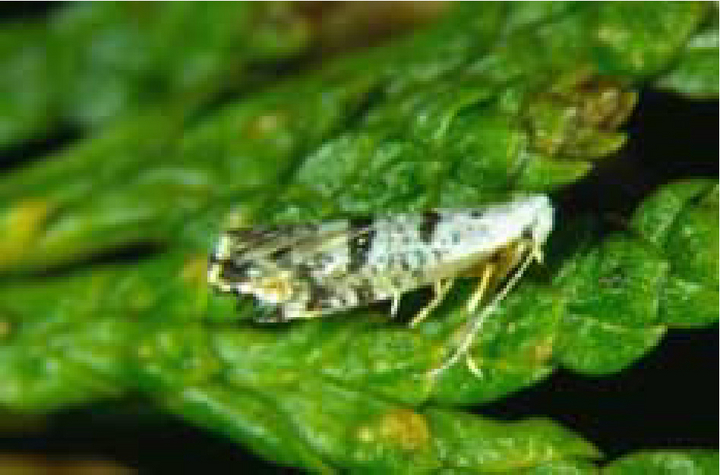Arborvitae leafminer
Argyresthia thuiella
Profile
The thuweed leaf miner is a small butterfly from the family of webs and bud moths. It originates from North America, but has spread widely in Austria due to the frequent cultivation of thuja. The leading symptom of an infestation by this small moth are brown colored shoot tips of the affected host plants due to the feeding activity of the young caterpillars.
Appearance

The moth has a wingspan of only 8 mm. Since it can easily be confused with other small flying insects in flight, one must wait until the moth has come to rest to recognize it clearly: the narrow, sword-shaped wings now rest against the body, revealing the silver-gray ground color with brown spots. The moth is also easily recognized by the fact that its body points obliquely away from its perching base - with the head almost resting against the base ("looking in").
The eggs are about 0.25 mm in size, creamy yellow and cushion-shaped.
Biology

The thuja leaf miner is a small butterfly from the family of gossamer and bud moths (Yponomeutidae). The female lays her eggs on small bumps - e.g. in the joint between two scale leaves. After three to four weeks (in the course of June), tiny caterpillars hatch from the eggs and immediately bore into a scale leaf, where they create their feeding tunnel. Later they enlarge this opening and transport their excrement crumbs through this now created "ejection opening" to the outside and clean their mine in this way. As a result, infested scale leaves appear as if they have been hollowed out.
The caterpillars in the fifth larval stage spend the cold season in a resting phase. With the onset of higher temperatures in spring, however, development is quickly resumed - eventually the larvae, which are now already in the sixth stage, pupate inside the hollowed out scale leaves. From these, a small butterfly hatches again after a short time. In this way, a generation of moths reaches development every season.
Damage symptoms

The leading symptom of an infestation with thuja leaf miner moths is brown-colored shoot tips of the affected host plants. On close inspection, the scale leaves appear hollow inside - this is particularly easy to see when held up to the light. An ejection opening can also be found on older mines. Fungal diseases or various environmental factors can cause similar damage. Before any treatments, it is therefore very important to first make sure that the damage is really caused by the moth to be assumed.
Prevention and control
- Cutting off and destruction of infested shoot tips.
- Spray treatment with a plant protection product approved for this purpose (see list of plant protection products approved in Austria).
The best time for treatment is given by the flight of the moths, which is usually in early June. An additional clue is also the beginning of the flowering of the wild vine. At this time it is convenient to take a closer look at the thuja in order to clearly detect possible moth flight.
Last updated: 11.09.2023
automatically translated